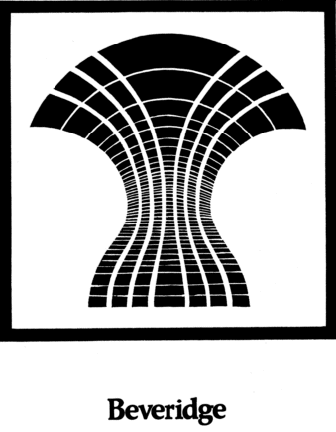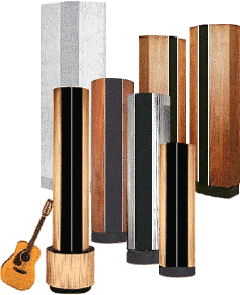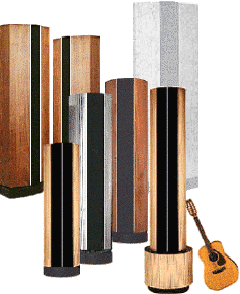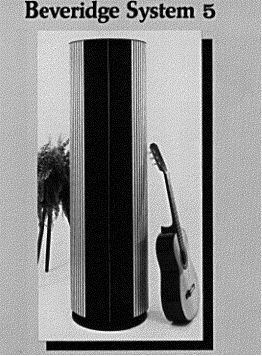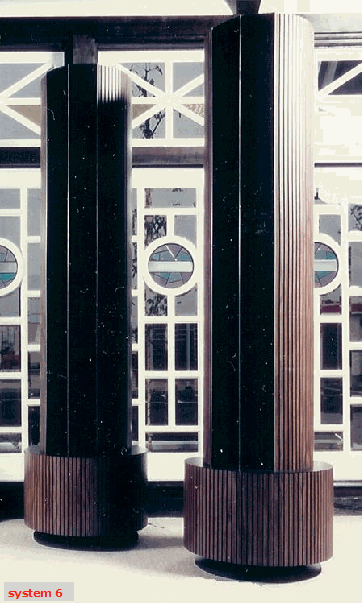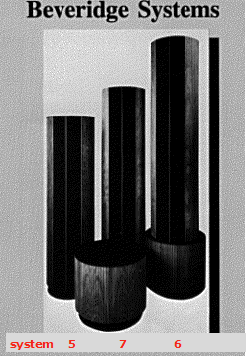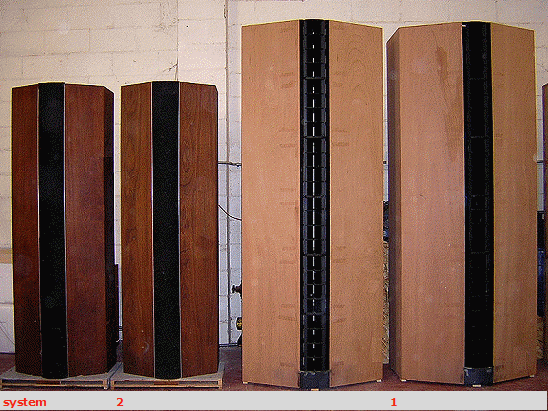|
|
|
|
|
The Beveridge 1 is an electrostatic speaker (Prototype).
Beveridge website (March 4, 2006): The Model 1 was the prototype: the first full range Beveridge electrostatic speaker to employ the patented, full-length Beveridge acoustic lens system. All subsequent Beveridge loudspeakers systems were based, in one form or another, on this Model 1 prototype. An oversized model, standing approx 6' tall and 3' wide, the "One" sported a voluminous and tall cabinet which covered almost the entire distance from floor to ceiling.
The Model 1 was, in a sense, a technology demonstrator and was never available commercially. A family friend had eventually acquired the system, but it is now believed to have been destroyed. Subsequent Beveridge models were all smaller. The Model 2 was similar in height, but only 2' wide. The Models 3, 5, and 6 were cylindrical in shape. The smallest in the range, the Model 5, was only 5' tall.
Rick Beveridge has recently started designing and building the "Model X", which will commemorate and honor the Model 1 prototype. It is reminiscent of that pioneering model in its dimensions, but acoustically the X is be far more advanced: while the bass response will resemble that of the "One" and will be substantially lower than past or current Model 2's, the unit will employ six transducers in each cabinet for a much increased total SPL across the audio range. The purity of the design is maintained; the entire frequency range is reproduced by electrostatic transducers only, with no band splitters. A new, enhanced, class A OTL power amplifier will directly drive the ESL units.
The Beveridge X-1 is an electrostatic speaker.
Beveridge web site (January 2009): The Model One was the first pair of speakers my father made utilizing his invention of an acoustic lens.
Each speaker measured six feet tall by three feet wide by some two feet deep. It was a single source, full range, wide dispersion cylindrical wavefront, monopole electrostatic loudspeaker. It was also an active speaker with its own dedicated integral OTL tube amplifier, developed by my father. The design's frequency range is unknown, but I believe it could go well into the 20 Hz range.
They performed beautifully in the very difficult room at our home on Franceschi Rd., on the hilltop overlooking Santa Barbara. I believe that it was this room that caused my father to conceive the idea of a vertical, wide dispersion cylindrical wavefront as well as the concept of the acoustic lens necessary to accomplish such a wavefront. This room was about 60 feet long by 20 feet wide (ending in a small L-shaped extrusion). At each end there was a solid wall with no windows. What made this room so difficult to work with was the fact that along each of the long walls there was about 30-40 feet of floor-to-ceiling interlocking sliding glass doors. These glass walls were parallel to each other and had a polished concrete floor between them for most of their lengths. There were curtains, but they were almost always pulled back into the corners. Very few speaker systems, then or now, can work with such a difficult room, but the Model One handled it beautifully.
Akio Morita, the founder of SONY Corporation, spent almost a whole week at our house, along with a battery of his engineers, investigating the performance of these speakers. He was so impressed that he wanted to buy out the entire design and produce it under the SONY name. Yet my father still had ideas relating to the many advantages of this acoustic lens and its perfectly uniform cylindrical wavefront which he wanted to develop further. Since the offer from SONY would have precluded any further involvement by my father into the project, he turned down Mr. Morita's offer.
When we decided to go into production ourselves, we realized that the Model One was too large to be commercially acceptable by the domestic market at that time. With the aid of Donald McFarland, a noted interior designer, my father rescaled and redesigned the cabinet; the first production speaker became the well-known Model 2. The scaled down version preserved all the sonic qualities of the Model One, except for an unavoidable reduction in bass extension. The Model 2 became a success, launching Beveridge straight to the top of the audiophile market.
Today, honoring that unique Model One, I am resurrecting and introducing the design in its radically new, modern format - the X-1. Although its width and depth remain relatively the same, it gains almost two feet in height. The most striking difference between the X-1 and Model One is the doubling(!) of its electrostatic radiating area. This doubling of radiating surface allows for a 3 dB gain in headroom over its predecessor.
The Model X-1 is a complex design. The doubling of the transducer area doubles the capacitive load placed on the amplifiers. Each speaker will require over 3000 VA (the same power required by a pair of Model 2s). The acoustic lenses are modified to take advantage of this greater surface area. They also retain the 180-degree polar dispersion of the original. The frequency range of the X-1 goes more than an octave lower than the Model 2. This enables the X-1 to be the first single source, truly full range electrostatic speaker ever, covering the entire audio range from 20 Hz up to 18 KHz.
This impressive and imposing mammoth of a speaker will appeal to the very few, whose appreciation for the wide frequency range of this speaker will override all other considerations.
The Beveridge 2 is an electrostatic speaker.
Beveridge web site (January 2009): It was our first production speaker. For information on its ancestor, the Model One, please click here.
The Beveridge Model 2 is a very unique loudspeaker and, in the opinion of many, the best speaker we have ever produced. It is a scaled down version of its predecessor the Model One, such that it can fit through doors and hallways.
It is an active speaker, driven by its integral OTL tube amplifier, capable of an equivalent output of 1500W. Its full range of 40 Hz - 15 KHz (+/- 2 dB, with useful output at 35 Hz) of 180 degrees cylindrical wave front is also referenced here. For more on cylindrical wavefront sound propagation, combined with the benefits of a monopole design, I suggest that you also visit JansZen.
The current Model 2 produced today has an entirely redesigned lens. This work was done by my brother Ross Beveridge of Colorado State University (computer department), employing his custom-developed software. These tools were totally unavailable to my father at the time. The net result of this development is, among others things, a smoother and more uniform amplitude front. In addition, the lens reinforcement is now accomplished, as it is in the Model G-3, by means of Microspheres and Epoxy resin.
The amplifier design and construction also benefits from 35 years of accumulated experience and technology improvements. High quality components are used throughout and modern manufacturing techniques are nowadays employed.
SPL, in and of itself, is not and never was the main objective in the design of the Model 2. In my opinion, the dynamic range of a speaker is of far greater importance. For dynamic range, the Model 2 is truly unsurpassed. It may not equal the G-3 in terms of total SPL, but it was, and it remains today, to be the only single source, full range, cylindrical wavefront, monopole, electrostatic, active loudspeaker system in the world.
Beveridge website (March 4, 2006): The Model 2 was the first commercial, full production Beveridge system. It is a full-range electrostatic speaker, employing the patented Beveridge acoustic lens system, driven by a built-in, Class A OTL tube power amplifier of high quality. It achieves a full 180 degree cylindrical-front waveform dispersion. As with all Beveridge speakers, the ES panel's rear radiation is totally absorbed within the enclosure, eliminating any interference or cancellation by rear-generated waves.
The Models 2 SW / SW-1 / SW-2, direct derivatives of Model 2, were aimed at increasing the speaker's total SPL. To that end, the main electrostatic transducer is relieved from reproducing the lowest octave. Two independent dynamic subwoofer enclosures cover the 30-70 Hz (sw) and 30-100 Hz (SW-1 / SW-2) range, crossed over by a built-in electronic network. The subwoofers are of the infinite baffle design. The electrostatic transducers continue to be housed in the Model 2-legacy, elegant cabinets, but the frontal sound slot is enlarged from 6" to 6.75", with a corresponding increase in throat width.
The Models 2 SW / SW-1 / SW-2's modified design of the acoustic lens takes advantage of the fact that the lowest fundamental octave is no longer reproduced by the electrostatic transducers. This allows the 2 SW-1 /SW-2 to achieve a total SPL increase of some 10 dB over the original Model 2. As with the earlier model, the SW / SW-1 /SW-2 electrostatic panels are driven by a built-in, Class A OTL tube power amplifier.
The subwoofers are driven by separate, solid state amplifiers (models 2 SW-1 / SW-2). An additional, external control module (CM-1) is added to the entire system (2 SW / 2 SW-1) and allows the listener a wide range of control over the system's reproduction characteristics (e.g., subwoofer integration, bass boost/cut, continuous stereo separation down to mono). The Models 2 SW / SW-1 / SW-2 produce a full 180 degree cylindrical-front waveform dispersion. As with all Beveridge speakers, the rear panel radiation is totally absorbed within the enclosure, eliminating any interference or cancellation by rear-generated waves.
The Beveridge 3 is an electrostatic speaker.It is manufactured from 1979 to unknown.
J.M. Willigens: I just found in a 19-year old catalogue a description of Beveridge "systems", as they called their hybrid transducers:System 3 -at 3500$ a pair had a 10x25cm woofer combined with an ESL medium/treeble, crossover was at 200 hz. The column of 50 cm diameter and 2m in heigth had a power requirement of min. 50W, max 300W, an impedance of 8 Ohm and a frequency response given as 20Hz to 20Khz within 3dB.Roy Toulan Jr.: The "sound" of the Beveridge System 3, as good as they are stock, can be improved to a significant degree, with the following mods/suggestions: 1. They should not be set up in a "normal" stereo configuration as suggested by other comments. The 3s should be placed as the Systems 2 and 2 SW are placed - at the side walls about one third the room length from the front wall and facing each other. This is the way Harold Beveridge exhibited the 3s at shows. 2. Do not use the "frequency contour" box (meant to go in a tape loop or in between preamp/amp). This passive circuit significantly affects the transparency of the ESL units. 3. Do try an external crossover. The internal hinge is at 200hz and the woofers simply are too slow that high up. Try crossing over at between 80 to 100hz with a very good electronic crossover. I have used the John Curl designed Symmertry 1A (experiment with by passing the caps with .00x value "super" caps for best subjective sound) with good results.4. Using the "external crossover" connections on the System 3 still leaves a oil cap in the circuit to protect the ESL units. I believe that this cap rolls the ESL at 100hz at 6bd. This cap has a subtle affect on the "purity" of the ESL. I have eliminated this cap by hard wiring speaker cable in front of the cap. The result is much better but caution is advised since the ESL unit is no longer protected against a mistake in external crossover setting.5. Change the woofers - the original woofers (2 in each cabinet) were coated paper - bextrene or carbon fiber are much better. A number of companies (Dyna, Focal, Seas, etc.) make nice 10" woofers that can be matched with and will work nicely in the System 3s.6. For best results, however, use external woofers - the System 3 "cabinet" is really a Sonatube coated with resin and covered with a light architectural tambour - not very solid. The tube resonates like crazy with two 10" woofers blasting away. I use two "prism" shaped boxes (picture a 4' h x 1.5' w x 1.5' d rectangular box standing 4' high, cut in half on the diagonal -looking from the top- and housing the two 10" woofers on the large diagonal face) which are tucked against the side of the System 3s cylindrical cabinet (that faces the listener) and the side wall. In some rooms this configuration has worked better with the woofers on the side of the System 3 cabinet away from the listener. In any event, the woofer cabinets must be as close as possible to the ESL units for appropriate integration. The removal of the woofers perhaps has the greatest resulting benefit on the sound of the 3s. My woofers are 10" Dalesfords set in an "infinite baffle" configuration. 7. With the woofers removed, stuff the top and bottom cavities with a good quality fiber fill. 8. Finally, use a good tube amp for the ESLs. With these mods/suggestions, the System 3s begin to take on the absolute purity of the System 2 with the capability of greater dynamic range and acoustic output. The most amazing thing about the System 2 (other than the presentation of an utterly natural soundstage) is its ability to present the lovely subtlety and nuance of live music at very low volume levels. The 3s are capable of 99% of this kind of subtle performance and 100% of the soundstage presentation, with some work. I believe that the ability of the 3s to achieve greater acoustic output is significant since, in my experience, the 3s (and the 2s) are able to "present" the music more realistically in larger rooms (thus requiring more acoustic output). The dispersion pattern of the Bevs' acoustic lense illuminates a large room, much like the real thing. In smaller rooms, this illusion is less apparent. Hurray, if these wonderful musical instruments are to be back in production. Arthur Vered (August 1, 1999): I welcome Roy Toulan Jr's. comments (below) on Model 3, although with some reservations. The panels will go down to 70Hz, and this indeed is the cut-off point of the oil cap (6db/octave). I would strongly recommend though, not to bypass the cap, whatever the sonic degradation it may introduce. If you make any mods in this respect, it should only be to replace it with a modern equivalent. The panels have very little output below 70Hz. Relying on an external xover CAN be hazardous, as its failure may entail the panels' as well. The evolution of Model 3 had two aims: a. to make the Beveridge technology and sound more economically palatable and - b. to increase its efficiency over the previous models. The least efficient model was System II which had no sub-woofers. The II-SW added two external sub-woofers enclosures, cutting the panels off at 70Hz!. This added some 10db headroom over the standalone IIs. The trade-off was of course adding "cones" and attempting to integrate them into the overall sound. These two models were active (built-in tube amps). Model 3 dispensed with the amplification (passive) and with additional sub enclosures, thus cutting cost. The penalty paid for including the subs into the main cabinet was resonance. Still, they cost half the II's.I should point out several major design difference between the 3s and the IIs. The acoustic lens ARE different, the front aperture being at least twice as wide as that of the IIs. It guides the sound waves differently. Also, the xover freq. was shifted up to 200Hz, although the panels, like the IIs, can work down to 70Hz. These two main mods far extend the efficiency of the IIIs over that of the II-SW. If you switch the IIIs to a 70Hz crossover point, you are back to broadly System II-level efficiency (slightly higher). This was not the design intention of the stock IIIs, although they can take it (it has provision for bypassing the internal xover network - but NOT the cap!).If you do lower the xover point to 70Hz, Roy's suggestion of external sub enclosures makes good sense. Mind you, Harold Beveridge already thought of that, as there is a model based on the IIIs which does precisely that.I would invite you though, to consider a different approach which I have suggested to Rick Beveridge. As the LS stands some 6 feet tall, both cones can be employed, as are, in a transmission line config. of that length. 6 feet long trans. line will reinforce the 40Hz freq. region (1/4 wavelength), will provide far faster bass response (in character with the panels) and will dramatically reduce resonance within the cabinet. Regarding placement of the LS, because of the design diffs. the IIIs can be placed in a classic stereo configuration. It would be interesting to know in what year did Roy attend a Beveridge demo of his systems. It may be very significant. I certainly heard them in both "classic" and "facing each other" placement in a largish room, and the former was found to be superior.As to Roy's "hurray" about these wonderful musical instruments being back in production - I can only join in with mine. If you have any doubt about the quality of these marvels, or perhaps marvel yourselves at what Roy, I, and others are on about, read the reviews in the review section.Arthur Vered Beveridge website (March 4, 2006): A semi full-range electrostatic speaker employing the Beveridge acoustic lens system. The Model 3 heralded the introduction of an entire new series - Models 5 and 6 - all based on the same elegant, tubular cabinet design. In contrast to the Model 2, the 3 boasts cylindrical cabinets, 6' 6" tall, each housing the ES units. Two additional woofers cover the lower acoustic range. A modified lens design retains the full 180 degree, cylindrical-front waveform dispersion. A further increase in sound slot width and a correspondingly larger throat to the wave guides allow a further increase in total SPL. Unlike previous models, the 3 is a passive speaker, giving the user the choice of power amplification. The cylindrical-front waveform is created by means of the acoustic lens and the vertical narrow line source at the front. As with all Beveridge speakers, the ES panel's rear radiation is totally absorbed within one sub-enclosure in the column. This, in turn, is entirely segregated from two other sub-enclosures that house the top and bottom woofers. Two additional 10" woofers/channel, covering the 30-200 Hz range, radiate upward and downwards, creating a perfect polar sound dispersion with no phase shift. A built in, bypassable cross-over network allows for a variety of bi-amplification modes, but the ES units are protected at all times by a fixed, non-passable high quality oil capacitor. Model 3's passive equalization is provided via a separate unit connected between pre- and power amplifier or into the pre-amplifier tape loop. It achieves similar tonal balance to that of the Model 2 - and does so to a remarkable degree - by simulating the latter's sound slope. It corrects a very mild peak around 10 kHz and provides bass boost/cut control.
The Beveridge 4 is an electrostatic speaker. It is manufactured from 1981 to unknown.
The Beveridge 5 is an electrostatic speaker. It is manufactured from 1982 to unknown.
Beveridge website (March 4, 2006): The smallest model in the Beveridge line borrows its name from its height - five feet tall. It is a semi full-range electrostatic speaker employing the Beveridge acoustic lens system. Resembling the Model 3 on a smaller scale, the 5 is a passive speaker, allowing the user the choice of his own amplification. The Model 5 is the only speaker in the Beveridge line to employ a single electrostatic element, a 3' x 1' transducer (all other models employ two or three transducers, of various dimensions, per cabinet). It is also the first to employ a circuit board transducer type, like the subsequent Model 6.
The cylindrical-front waveform is created by means of a modified acoustic lens, coupled with the vertical narrow line source at the front, yielding a maximum 90 degree, cylindrical-wave dispersion. As with all Beveridge speakers, the ES panel's rear radiation is totally absorbed within the enclosure, eliminating any interference or cancellation by rear-generated waves.
The Model 5's 12" woofer, housed in the main column (a 24" tall x 18" diameter, cylindrical chamber), covers the low audio range (30 - 250 Hz). A built in, bypassable cross-over network allows for a variety of bi-amplification modes, but the ESL unit is protected at all times by a fixed, non-passable high quality capacitor.
The Beveridge 6 is an electrostatic speaker. It is manufactured from 1984 to unknown.
Beveridge website (March 4, 2006): A semi full range electrostatic speaker, employing the Beveridge acoustic lens system - the last model designed and built by Harold Beveridge. Resembling the Model 3 on a somewhat larger scale, the 6 is also a passive transducer, allowing the user the choice of his own amplification. It improves on the Model 3, however, by adding two additional external sub-woofers (similar to Model 2 SW-x), housed in their own independent, circular enclosures. This reduces coloration and unwanted resonances within the main ES cabinet. The cylindrical front waveform is created by means of the acoustic lens, coupled with the vertical narrow line source at the front, allowing a 90 degree cylindrical-waveform dispersion. The Model 6 employs four of the same circuit board type transducers used in the Model 5. As with all Beveridge speakers, the ES panel's rear radiation is totally absorbed within the enclosure, thus eliminating any interference or cancellation by rear-generated waves. The Model 6 employs a 12" woofer/channel, covering the lower audio range (33 - 200 Hz). A built in, bypassable cross-over network allows for a variety of bi-amplification modes, but the ES units are protected at all times by a fixed, non-passable high quality capacitor. Note: Around 1980, the design, and possibly a limited production of, a "half amp" had begun, with the view to offering Model 6 customers a direct drive OTL amplifier. This was essentially a cut-down version of the Model 2 amplifier (employing only a pair of tubes and operating at half the voltage). Only a limited number of units were ever produced and sold, however, and the effort was aborted.
The Beveridge 7 is an electrostatic speaker. It is manufactured from 1987 to unknown.
|
|
|
|
|
|
